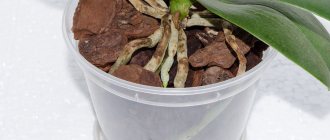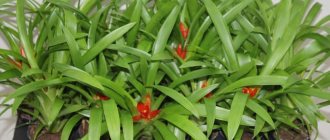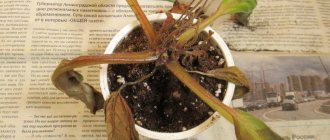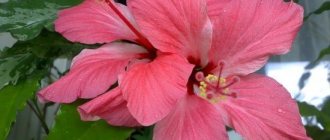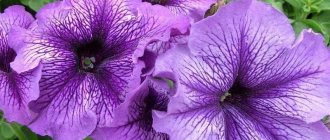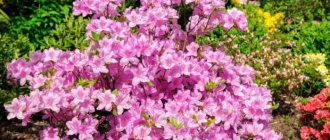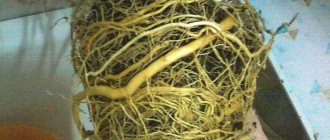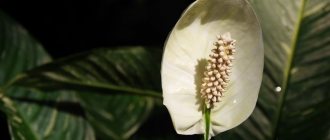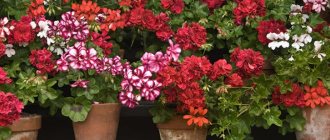Propagating orchids by seeds is a rather labor-intensive and difficult process. Inexperienced gardeners are not always able to grow a new plant from seeds. Indeed, in their natural environment, epiphytic orchids experience certain difficulties with such reproduction. Seeds must be exposed to favorable conditions in order to germinate. It should be noted that small orchid seeds practically do not contain nutrients that are so necessary for further development. Therefore, you should use a nutrient medium for their germination at home.
Professional advice on how to pollinate phalaenopsis at home
Phalaenopsis has long ceased to be an exotic thing that is scary to touch and you just want to admire from the outside. Many flower growers, after purchasing another specimen, wonder how to propagate this orchid not only vegetatively, but also grow seedlings or obtain hybrid plants .
However, it is worth remembering that if pollination is successful, the plant spends a lot of energy on producing seeds and may not bloom for a long time. Below you will learn how phalaenopsis pollination occurs at home.
How to determine the result
After pollination of an orchid at home, noticeable changes begin to occur in the flower. Both flowers, the one from which the pollinia were used and the one to which they were applied, die. The first one dries up and falls off. The second one changes differently.
If pollination is successful, the hole with the placed pollinia closes after 24 hours. The petals begin to fade and dry out, but they do not fall off. The base of the flower swells, indicating that the seed pod will begin to form. This usually takes 6 to 8 months.
During the ripening process, it is necessary to monitor the development of the capsule and changes in its color. As soon as it turns yellow and begins to acquire a brownish tint, it should be picked. There is no need to wait until full ripening, at which point the boll may crack, which will lead to certain difficulties with sterilizing the seeds during sowing. But you should remember that if you remove the box ahead of time, you can get unripe seeds.
When the development of the box reaches three months, you can put a bag of airtight fabric on it. This will prevent the seeds from scattering if the boll cracks. Before use, the bag must be boiled.
We recommend watching a video about pollination:
Pollination of phalaenopsis orchid
Prerequisites
Getting seeds yourself is practically the only way to get seedlings.
It is impossible to buy seeds of this plant.
In most cases, if phalaenopsis seeds are on sale, it is only a scam from unscrupulous sellers.
In addition, phalaenopsis seeds lose their viability very quickly , so you have to master the intricacies of independently obtaining seeds for sowing.
It is almost impossible to obtain phalaenopsis seeds.
Forms
In the plant world, 2 types of pollination :
- Self-pollination or autogamy;
- Cross.
In the case of orchids , self-pollination is not possible because the structure of the flower does not allow male pollen to reach the stigma of the pistil unaided.
Cross pollination can occur as:
- Within one plant - geitonogamy (when pollen from one flower lands on the stigma of another flower on the same plant);
- between different plants .
Possibilities
Phalaenopsis is characterized only by cross-pollination , i.e. Pollen from one flower lands on the stigma of another flower.
Pollen sometimes forms interspecific and even intergeneric hybrids , which are quite possible to obtain at home .
At the tip of the flower's stigma there is a column of pollen containing pollen.
The sticky “tails” of pollinia are designed to cling to the backs of pollinating insects and use them to get onto other plants.
In nature, self-pollination is impossible , but at home it is quite likely that when a flower is pollinated by its own pollinia, an ovary is also formed.
If you have several plants flowering at the same time,
hybrid pollination .
It is this type of pollination that allows:
- Get a variety of colors of flowers and leaves;
- Plant sizes.
It is difficult to predict what hybrid seedlings will be like , but among the diversity there may well be very interesting specimens.
Technology at home
With the necessary theoretical preparation, special skills for pollination are not required.
All you need is patience and accuracy .
A basic set of tools , such as tweezers and a toothpick, will be quite enough.
The pollination procedure can be divided into several stages:
Rules for pollinating phalaenopsis at home:
- Removing the boot cap. The anther cap must be separated from the stigma using tweezers or a toothpick . Typically, the pollinia are found inside the cap and rarely remain on the plant. They are 2 small yellow balls on a common sticky stem;
The anther cap must be separated from the stigma using tweezers or a toothpick.
- Extraction of pollinia from anther. The pollinia must be carefully separated from the cap, while not touching the anthers , but holding them by the “leg”;
- Inserting pollinia into the column niche. At the bottom of the column you can find a small recess into which you need to place the pollinium.
The pollinium should be the only object that touches the stigma of the flower.
How to determine the result
After such manipulations with a flower, you don’t have to wait long for changes.
Regardless of the result, the flower from which the pollinia was taken and the flower to which they were transferred will wither within 24 hours .
The first flower will simply dry out and fall off, and the fate of the second flower will depend on the success of the procedure.
If pollination has occurred, then after a day the hole in which the pollinia were placed will close .
The petals of the flower will begin to wither and dry out, but it will not fall off.
Instead, the base of the flower , by which it is attached to the main peduncle, will begin to swell , i.e. A seed box will form.
Formation of a seed box.
This process may take 6-8 months.
This is exactly what is needed to increase the capsule to its maximum and ripen the seeds.
It must be taken into account that when fully ripe, the capsule will crack , releasing dust-like seeds.
If cracking is allowed, then when sowing on a nutrient medium, difficulties may arise with sterilization of the planting material.
Therefore, after reaching the maximum box size, you need to monitor:
- Change in its color;
- If it turns yellow, pick it off, avoiding cracking.
How to pollinate orchids and collect their seeds
Let us describe in detail the process of pollination and collection of seeds for further propagation of the orchid.
Reference! Most small-flowered orchids are difficult to propagate by seed.
Which plant to pollinate
For pollination, it is recommended to choose strong and healthy plants. If one orchid is larger than another, pollen is taken from the larger one and transferred to the smaller one. If you act differently, there is a high probability of obtaining a minimum number of viable seeds.
You cannot take those plants that were propagated by dividing the bush, or those that bloom only for the first year.
Reference! The flower from which pollen will be taken must be open for at least 1-2 days before pollination.
How to pollinate
Before the pollen is transferred to the flower, the pollinia are removed from it. To remove the paper, place it under the tops of the column, and then gently press on the anther cap (this is done exclusively from the bottom up). For the procedure, it is better to take a toothpick.
After these manipulations, the anther chamber is usually separated from the flower. At the same time, the pollinia are pushed out as carefully as possible, without touching them. The stigma is first touched with the instrument and only then the pollinia. With this order, they should easily attach to each other.
The process of pollination itself occurs by pressing the stigma of the pollinia to the liquid. Sometimes the flower wilts within a couple of hours, and sometimes it takes a couple of days. To avoid rotting, it is recommended to cut the petals to the very base. It is not recommended to touch the pod when forming the column.
How the pod develops
Enlargement of the ovary is the first reaction to pollination. It is too early to say that the process was successful. Incompatibility of flowers with pollen is often observed, and it manifests itself in different ways. The initial signs of incompatibility are drying out of the column.
Reference! Sometimes even a pod that has developed normally can turn yellow after a few weeks. In this case, the culture will simply reset it.
With proper pollination and successful fertilization, the ovary constantly increases in size. During the development of the ovary, grooves (3 pieces) appear on it - their sizes correspond to the grooves visible even before pollination.
After six months, the pod will be the size of a lemon. Growth ends here and maturation begins, requiring a long period of time (up to 10 months).
What the seeds look like: description and photo
The seeds of representatives of the Orchid family are so small that they are often perceived as specks of dust. Parameters of orchid seeds:
- length - 0.3-0.35 mm, width - 0.08-0.3 mm;
- elongated, narrow shape;
- shade light brown, cream or beige.
One seed capsule can contain up to 5 million seeds. However, only a few take root.
How and when to collect seed
When fully ripe, the pod cracks, usually in the groove area. If this process is noticed, the pod is immediately cut off. Otherwise, it will crack completely and it will be too late to collect the material. To eliminate such an unpleasant situation, experienced gardeners tie the ripe pod with papyrus paper (the manipulation is carried out even before cracking begins).
The ripe seed box is cut off immediately with the pod and pseudobulb. After the box dries and opens itself, the seeds are removed from it and stored in a dry and clean closed container.
All the roots of an orchid have rotted, how to save the plant and give it a second chance
Complexities and subtleties
What is the fate of the phalaenopsis after receiving the seed capsule?
Some plants die after pollination and seed ripening , but this is not typical for orchids.
Of course, the ripening of seeds depletes the plant, but with proper care and timely feeding, phalaenopsis will be able to quickly recover and bloom again .
Is it possible to pollinate several flowers on one plant?
It is quite possible to pollinate all the flowers on the peduncle, especially since if even one flower is successfully pollinated, the untouched flowers will not bloom for a long time .
Pollinating several flowers at the same time significantly increases the chances of getting seeds , but leaving too many boxes on one peduncle is not recommended.
Pollinating several flowers at the same time greatly increases the chances of producing seeds.
It is better to remove excess ovaries so that the remaining ones can fully develop .
Is it possible to pollinate plants of different species?
Closely related species quite often form hybrids even in natural habitats.
In culture you can often find not only interspecific, but also intergeneric hybrids, such as:
- Doritenopsis;
- Asconopsis;
- Vandenopsis;
- Renanthonopsis.
Orchid at home
Delicate and exquisite butterfly flowers have not lost popularity for many decades. This is not surprising, because the luxurious royal flower will decorate any interior and fit perfectly into almost any style. But, like any royal person, an orchid requires careful handling and proper maintenance conditions.
In this article we will talk about growing orchids at home.
Planting an orchid at home
The most popular variety of home orchid is phalaenopsis, mini phalaenopsis. We will consider the process of transplanting orchids using his example. The proposed algorithm of actions is suitable for most epiphytes.
If you have an orchid in your home, the first thing you should do for it is to carefully examine the root system. If you notice that the roots are covered with dark spots or are rotting, the plant should be replanted immediately. If the plant looks healthy, and even blooms, it is better to refrain from replanting. At least until the end of flowering. It is advisable to quarantine new plant specimens after transplantation for 2-3 weeks.
Orchids: love with and without rules...
The Orchid family is the largest among flowering plants, it unites 25 thousand species. These plants were able to master all imaginable and unimaginable habitat conditions - from the deserts of Western Australia to the forests of Central America, from the remote mountain peaks of the Mediterranean to homes and offices around the world.
What is the secret of their success? In short - in deception. Although some orchids offer nectar rewards to the insects and birds that pollinate them, about a third of species economize on nectar and increase their chances of reproduction by cleverly deceiving the insects—visually, olfactorily, tactilely, or all three. Some orchids, such as Dracula, lure bees by imitating the appearance of nectar, while others attract midges by releasing unpleasant odors - from the smell of rotten meat or mushrooms to cat urine or a baby diaper. Some only make a promise by unfurling insect-like flower shapes. Others imitate male bees in flight, hoping to spark a territorial fight that will lead to pollination.
But perhaps the smartest deception of those orchids that offer sex is not entirely normal. One of the most ingenious and diabolical orchids in this regard is Ophrys, which some botanists call the “prostitute orchid.” Its pollination strategy is called "pseudocopulation" - a sexual deception that forces a radical reassessment of what a smart plant can do to a gullible animal. In the case of Ophrys, the animal is a relative of the bumblebee. The orchid does not give nectar or pollen as a reward; it seduces the male, imitating the female with its appearance, smell, and even tactile sensations that it gives to the insect.
These small orchids grow like weeds in the mountains of Sardinia. In appearance, they resemble a female bee with folded iridescent wings, buried in a green flower formed by the sepals of a real flower. To enhance the deception, orchids emit a scent that exactly replicates the pheromones of a female bee. A drone lands on the lower lip of a flower resembling a bee in an attempt to copulate. In the midst of his long and fruitless efforts, two yellow sacs of pollen, called pollinia, become stuck to his back with a quick-drying jelly-like substance. They look like a pair of plump oxygen tanks strapped to your back. A hunch finally dawns on the drone, and it abruptly flies off in search of real female company, carrying pollen to other plants.
ORCHIDS AND THEIR POLLINators
Flowers are one of nature's most beautiful creations. Of course, for a plant, a flower is not just a decoration, but a way to attract the attention of pollinators and thereby ensure continuation of the species, but this does not prevent us from admiring the exquisite perfection of flower forms and the brightness of colors. We present to our readers a magazine version of an article from the book “Flowers of the World,” recently published by the Avanta+ publishing house in the “The Most Beautiful and Famous” series. From thousands of species of beautifully flowering ornamental plants and hundreds of thousands of their cultivated varieties, the compilers have chosen those that can give the most complete idea of the beauty and amazing diversity of the plant world. The book, written by leading botanists and flower growers, tells not only about individual species, but also about flowering plants as a whole - their structure, adaptation to the environment, and unusual properties. It also contains useful practical information: about caring for garden and indoor flowers, about arranging a bouquet and about flower etiquette. Photojournalist of the magazine “Science and Life” I. Konstantinov took part in illustrating the book.
Science and life // Illustrations
Nectar from the narrow spur of Comparettia macroplectron can only be obtained by hawk moths with a long proboscis.
Blue vanda flowers are pollinated by Hymenoptera, which are more susceptible to the ultraviolet part of the spectrum.
Numerous scarlet clusters of Rodriguezia secunda (Rodriguezia secunda) are ideally suited to hummingbird pollination.
The ivory-colored flowers of Angraecum eburneum attract night hawk moths by scent rather than color. An upturned lip does not prevent butterflies from hovering over a flower, fluttering their wings.
Dendrobium secundum, widespread in Southeast Asia, is called the “toothbrush orchid.”
Calliphorid carrion flies play a special role in the pollination of some masdevallias and bulbophyllums.
Vanilla flatifolia.
“Shooting” catasetum pileatum.
Scheme of the structure of the lady's slipper flower
The brownish-yellow flowers of Oncidium look like male Hymenoptera of the genus Centris, so insects attack them, mistaking them for rivals.
The flowers of some orchid species resemble female insects in shape and smell.
Hummingbirds pollinate many species of orchids and other plants.
White-lipped oncidium (Oncidium leucochilum). The huge lip of the flower serves as a “landing platform” for pollinating insects.
The amazing paphiopedilum argus slipper is named after the hundred-eyed giant Argus because of the many dark dots on the petals. The shoe-shaped lip and the shield-shaped staminode above it serve as a trap for pollinating bees.
‹
›
Reproduction issues are not easy for plants to solve, because unlike animals, which find their own partners by moving freely in space and relying on sexual instincts, plants are forced to trust their precious pollen to random “intermediaries” - water, wind, insects or animals.
Orchids, as the youngest family of the plant world, appeared on our planet approximately 25-30 million years ago, when all modern forms of plants had already adapted to the surrounding world. Orchids had to use deception and cunning to win pollinators from other flowering plants. As a result, some orchids have developed such a narrow specialization that they have become completely dependent on a specific (often single) pollinator.
What helps orchids successfully solve cross-pollination problems? First of all, the duration of flowering. In most species, flowers do not fade for weeks or months while waiting for pollinators. Often, flowers in an inflorescence bloom alternately, and flowering extends for an even longer period. In some tropical epiphytic species pollinated by flying insects, the inflorescences reach a considerable length (more than three meters in Oncidium leucochilum), carrying the flowers beyond the crown of the host tree - this way they are more noticeable to pollinators. Adapting to pollination by crawling insects, orchid inflorescences, on the contrary, are greatly shortened and pressed against the substrate.
Another adaptation of orchids to insect pollination is the twisting of the flower ovary by 180 degrees (so-called resupination). Thanks to this property, the lip of the flower is always at the bottom and serves as a “landing platform” for insects. If the orchid is pollinated by butterflies that hover over the flower, and the lip can prevent their wings from moving freely, the ovary twists even more and makes a full revolution around its axis, raising the lip to the upper position. If the flower is turned down, as, for example, in Stanhopea or Gongora, then the lip serves as a kind of slide from which insects slide down, producing pollination, while the ovary does not curl at all.
Hymenoptera - bees, bumblebees and wasps - make up half of the orchid pollinators. All representatives of this order of insects are closely related to flowering plants: they absorb nectar and collect pollen to feed the larvae. Hymenoptera are good at distinguishing colors, smells, and remembering the outlines of objects. In the color spectrum, they perceive the ultraviolet part better, but at the same time they do not capture pure red color - for them it merges with the background. Orchids that have chosen hymenoptera as pollinators have adapted to this feature by excluding all shades of red from their diverse range of colors. Special patterns on the corolla help the insect find the way to the nectar inside the flower. Sometimes flowers form complex traps and passages, forcing bees to enter and exit only along a certain path, as a result of which the insect inevitably encounters a column and flies out of the flower with a pollinarium attached to its body - a lump of pollen equipped with a stalk and a sticky disk. An important role in attracting pollinators is played by the pleasant sweet smell of flowers, which intensifies during the day, when worker bees are most active.
Bees pollinate all lady's slippers - Cypripedium from temperate latitudes of Eurasia and America, Paphiopedilum from Southeast Asia, as well as Phragmipedium and Selenipedium from tropical America. Their flowers are arranged in a general pattern that is different from other orchids. The shoe-shaped lip, flat shield-shaped staminode (sterile stamen) and column are combined into a simple trap like a fisherman's top. Lady's slipper flowers do not produce nectar, and the oily liquid that sometimes appears on the hairs of the back of the lip does not attract insects as food. The pollination strategy of these plants involves a decoy (a bright spot on the staminode) and duration of flowering. During the time that the flower remains fresh (two to three months), some bee will definitely take an interest in it and fall into the trap. Getting out of it along the back wall, the insect will be forced to squeeze first past the stigma, and then through one of two narrow slits formed by the lip and staminode, partially blocked by pollen masses. Here the bee will inevitably smear itself with sticky pollen, and then transfer it to a neighboring flower (for pollination of lady’s slippers, see “Science and Life” No. 9, 1985).
Drones do not collect nectar, so to attract them, the flowers of some orchids (Coryanthes, Stanhopea) have a special bait - glandular epidermis on the lip, which has a narcotic effect. Gnawing the epidermis, the drone becomes immobilized for a while and falls down. In order for bees to successfully pollinate even in this state, orchid flowers prepare all kinds of traps for them. Stangopei suggest a ride along the lip, as if on a slide, and corianthes suggest taking a cold bath.
The lower part of the corianthes lip is transformed into a kind of bucket, above which there is a constantly “dripping tap” - two special narrowed appendages of the lip that secrete abundant liquid. During flowering, each Coryanthes speciosa flower releases about 30 grams of liquid. To prevent the bucket from overflowing, excess liquid is poured out through a special tube at the tip of the lip. Directly above this tube is the end of the column bearing the pollinaria.
Male euglossa bees are attracted to the corianthes flower by its strong aroma. Drones land on the edge of the lip and bite off the glandular epidermis from its back surface. In the heat of the struggle for a place at the “dining table,” the drugged drones fall into the “bath.” It is not easy to get out of it; it often takes a wet bee more than half an hour to find the only way out - through the drain tube adjacent to the column. The passage is very narrow, and the bee is forced to forcefully squeeze between the end of the lip and the column. In this case, the pollinaria stick to the insect, which, having barely dried, is ready to visit a new flower. As a rule, after removing the pollinaria, the flower temporarily loses its strong sweet aroma, but the smell reappears the next morning.
Particular mention should be made of bumblebees and eugloss bees that pollinate dioecious orchids. These insects are subject to a real “artillery attack” from the male flowers of Catasetum and Cycnoches. The disturbed pollinarium shoots forcefully at the unwary insect and sticks tightly to the abdomen. Flying to a female flower, which, unlike a male one, is always oriented in space with its lip up, a bumblebee or a bee leaves pollen in the stigmatic fossa and thereby performs the act of pollination. Although the chance of an insect that has already captured pollinaria meeting a female orchid flower ready for pollination is negligible, this is precisely the reproductive strategy that these plants chose in the wild.
Orchids attract male Hymenoptera to pollinate, using not only their feeding instincts. For example, males of the genus Centris, protecting their territory from competitors, attack the brownish-yellow flowers of Oncidium, mistaking them for rivals.
Often, orchid flowers secrete pheromones - volatile substances similar in composition to the secretions of insect glands, thereby influencing the sexual instincts of their pollinators. In many species of Ophrys, flowers in size, color, shape and arrangement of spots and patterns imitate females ready for mating. Males of some species of stinging bees begin to fly in early spring and earlier than females. At this time, the ophryses bloom, and the males try to mate with the flowers, mistaking them for females.
Lepidoptera pollinate about 18 percent of orchid species, and flowers pollinated by day butterflies and flowers pollinated by night butterflies have significant differences. Daytime butterflies are excellent at distinguishing colors, preferring flowers of red, pink or yellow color. They need a “landing platform” in order to sit comfortably on a flower that is fragrant in the morning and afternoon. Of course, the aroma attracts them to orchids, but the main guidelines are still the color of the corollas and the pattern on the petals. Orchids pollinated by hawk moths have completely different flowers. To search for food plants, these butterflies use smell rather than vision. The flowers of such orchids are usually white or pale in color, with a very strong aroma that intensifies at night. Possessing an elongated sucking mouthpart, hawk moths can extract nectar from long spurs where other insects do not have access. Moths feed without sitting on a flower, but hovering over it for a while, so all parts of the flower, including the lip, are positioned so as not to interfere with the fluttering insect.
Diptera pollinate about 12 percent of all orchid species. Mosquitoes and nectar-feeding flies are attracted to the sweet aroma of the inconspicuous small flowers, which are white, yellow or greenish-brown. These flowers, as a rule, have a lip without a guiding pattern and open nectaries that are easily accessible to insects. Sometimes mosquitoes and flies compete with small night moths in the fight for nectar.
Birds pollinate only about three percent of orchids. In the tropics of Southeast Asia and Oceania, these are tiny sunbirds, weighing no more than a few grams. In Central and South America, orchids are pollinated by hummingbirds. Although different types of hummingbirds weigh only 1.6 to 20 grams, they eat twice their body weight during the day. For hummingbirds to function normally, flower nectar alone is not enough, so a significant portion of their diet consists of small insects, which are found in abundance near orchids blooming on trees. A truly enchanting sight is represented by hummingbirds shimmering with all the colors of the rainbow, scurrying over the bright flowers. Hummingbirds suck nectar on the fly, hanging in the air, like hawk moths. With its long tongue, forked at the end, the hummingbird penetrates inside the flower, takes several active sips, takes off like an arrow and again hovers over the neighboring flower.
Birds have a poorly developed sense of smell, so the orchids they pollinate have a very weak aroma or no smell at all. But birds perceive colors in the same spectrum as humans: they are attracted to large flowers with bright red, pink or yellow colors that can hold a large amount of nectar. It is interesting that in many orchids, the pollinia (pollen clumps) of which are carried by birds, the pollen is black-gray or greenish in color - to match the color of the beak. Apparently, the bright yellow pollinia would stand out too much on the beak; Having noticed them, the bird would clear off the half-lines without delivering them to their destination.
The vanilla orchid flower, or Vanilla planifolia, is greenish-yellow in color, with a long tubular lip equipped with longitudinal projections and a transverse brush; the stigma is hidden deep inside the lip. The flower opens early in the morning and begins to fade in the afternoon, emitting a characteristic citrus aroma.
The shape and outgrowths of the lip, the color of the corolla, the nectary hidden deep inside the flower, and the short lifespan of the flower indicate that vanilla is pollinated by bees. In the homeland of vanilla, in Mexico, these are small stingless bees from the genus Melipona.
When vanilla began to be bred to produce a spice (the fruits of this orchid-liana fermented in a special way) far from Mexico, the problem of its pollination had to be solved. Eventually the Mexican bees were replaced by human hands. All existing plantations in Madagascar, Comoros, Reunion and Indonesia are pollinated artificially. And this is 1.5 billion vanilla flowers, from which up to 2000 tons of spice are extracted! Therefore, we can say that people, along with insects and birds, are full members of the diverse and numerous community of orchid pollinators.

